



If you are looking at this page without frames, there is more information about medieval writing to be found by going to the home page (framed) or the site map (no frames).
.
| Herbals and Medical Texts | |||||
| The area of medicine is one in which there are interesting relationships between different systems of knowledge in the middle ages. Ancient texts were copied and recopied while the profession of physician became a learned and literate one, incorporating fields of knowledge such as philosophy, religion, magic and astrology as well as the practical knowledge we associate with medical practice. At the same time, illiterate practical experts delivered babies, concocted natural remedies from the living world around them, set bones, used charms and said prayers for the mass of people too poor to afford the literate experts. |  |
||||
| A virtuous man visits the sick in a 15th century stained glass window in the church of All Saints North Street, York. Note the commode beside the sick man's bed. | |||||
| Medical care and treatment in the middle ages was constrained by the fact that they had no knowledge of two of the most significant areas of modern medicine; the nature and causes of infectious disease and the biochemical nature of metabolic processes. While this severely restricted the range of effective remedies that they had at their disposal, and made some of the ones they did have rather dangerous, they probably had more knowledge than they are often given credit for. Furthermore, religion and superstition did not prevent them from acquiring knowledge, although it must have given them something to fall back on when their knowledge failed them. | |||||
| A valuable work on this subject is Jones 1984. The Medieval Manuscripts in the National Library of Medicine website shows a large number of examples of medical texts, while the Index of Medieval Medical Images provides images of manuscript pages in a database format. | |||||
| In the era of monastic copying of books, up to around the 12th century, various works from the Classical tradition were copied and recopied in monastic scriptoria. These included herbals, or books with exquisite botanical illustrations with a commentary on their various curative functions. Certain works were carried along through chains of transcription and copying of the miniatures, without reference to the living world outside. Plants from northern Europe were not added to the Mediterranean selection of the original work, nor were the pictures updated with reference to the local meadows and woods. This, as in other works like the bestiary, was the study of literacy more than the study of practical knowledge. While exotic plants we know today to have effects on human metabolism, like the opium poppy or the cannabis plant, occupied the pages of the herbal, the practitioners who actually administered herbal remedies in colder climates must have had another, non-literate source of knowledge of their local species. | |||||
| The Bodleian Library illustrates a series of images from a late 11th century copy of the Herbal of Pseudo-Apulieus (Bodleian Library, MS Ashmole 1431) and from another volume of similar date with assorted texts of Herbals and other medical Knowledge (Bodleian Library, MS Bodley 130). An image from an Italian Herbal of around 1500 (University of Vermont Library, MS2, f.3) is displayed on The Index of Medieval Medical Images. | |||||
 |
When book production became commercialised around the 13th century and medicine became an area of study within the universities, a greater array of texts of a practical nature appeared. Books of remedies included the complex concoctions mixed up by apothecaries as well as the simple natural remedies. There were books discussing anatomy and such matters as the normal and abnormal presentation of foetuses in the womb. There were written aids for diagnosis and instructions for surgical procedures. There were instructions for regimes of such procedures as bloodletting and enemas. The medieval physician or surgeon had practical remedies for many things, but the unseen forces over which he had no control made his work an uphill struggle. | ||||
| The apothecary's shop is illustrated in the stained glass windows of Chartres Cathedral. | |||||
 |
Despite certain remedies, living with pain must have been a fact of life in the middle ages. The image of a man with toothache is a common one in medieval carved grotesques. This one comes from the parish church of Mugginton in Derbyshire. | ||||
| The Bodleian Library displays a series of illustrations from a late 12th century volume of miscellaneous medical and herbal texts (Bodleian Library, MS Ashmole 1462). The images include plants, surgical procedures, animal imagery and figures from Classical mythology. Don't think too hard about the images of cataract surgery or removal of nasal polyps if you have just had breakfast. | |||||
| The medieval physician was not fundamentally a technician, as today. He brought many fields of thought, derived from literary study, to bear on his art. Texts from Classical authors such as Hippocrates and Galen were studied and contributed much to the philosophical basis of medical thinking. The body was thought to be under the influence of various conflicting forces which had to be kept in balance. As a metaphor it has much to recommend it, but unfortunately it remained a metaphor because of a lack of more specific knowledge. | |||||
| A page from a 13th century translation into Latin of Hippocrates, with a historiated initial and festooned with various glosses, appears on the web here. | |||||
| Arabic texts, which had themselves drawn on the Classical authors and added a great amount of practical knowledge, were translated into Latin and formed tha basis for university teaching of medicine. The crusaders are sometimes given the credit for introducing Arabic medicine to the west, but more likely it was scholars and librarians. | |||||
| Information about and images of Arabic medical manuscripts can be found at Islamic Medical Manuscripts at the National Library of Medicine. | |||||
| The most commonly employed diagnostic tool of the medieval physician was the examination of urine. From its appearance and colour he was supposed to be able to discover the current state of bodily balance, and thereby instigate measures to restore it to health. The image of the doctor with his urine flask was one which received much parody. In the 14th century particularly, monkeys with urine flasks appeared in the borders of manuscripts and stained glass windows, peering gravely into the contents. It is probably no accident that these images appear in great profusion at a time when bubonic plague was mocking all the efforts of medical knowledge to tame it. By the late middle ages, doctors were carrying around little folding books of essential information, which they carried attached to their belts. These included charts for urine diagnosis. Written medical knowledge was no longer an academic exercise in scholarship, but was brought right to the patient's bedchamber. |  |
||||
| A monkey with a urine flask in a 14th century stained glass window in the nave of York Minster. | |||||
| A urine wheel from a 14th century physician's belt book (Rosenbach Museum and Library, MS 1004/29, f.9) is displayed by The Index of Medieval Medical Images. | |||||
| The most commonly employed practice for restoration of the bodily balance was bloodletting, either by opening a vein or by the application of leeches. Different parts of the body were considered efficacious for particular forms of imbalance. The physician's belt book could serve as a crib for this practice as well. | |||||
| Image of a phlebotomy man, from the same manuscipt as illustrated above (f.8), showing the bloodletting points. | |||||
|
|
|||||
|
If you are looking at this page without frames, there is more information about medieval writing to be found by going to the home page (framed) or the site map (no frames). . |
|||||